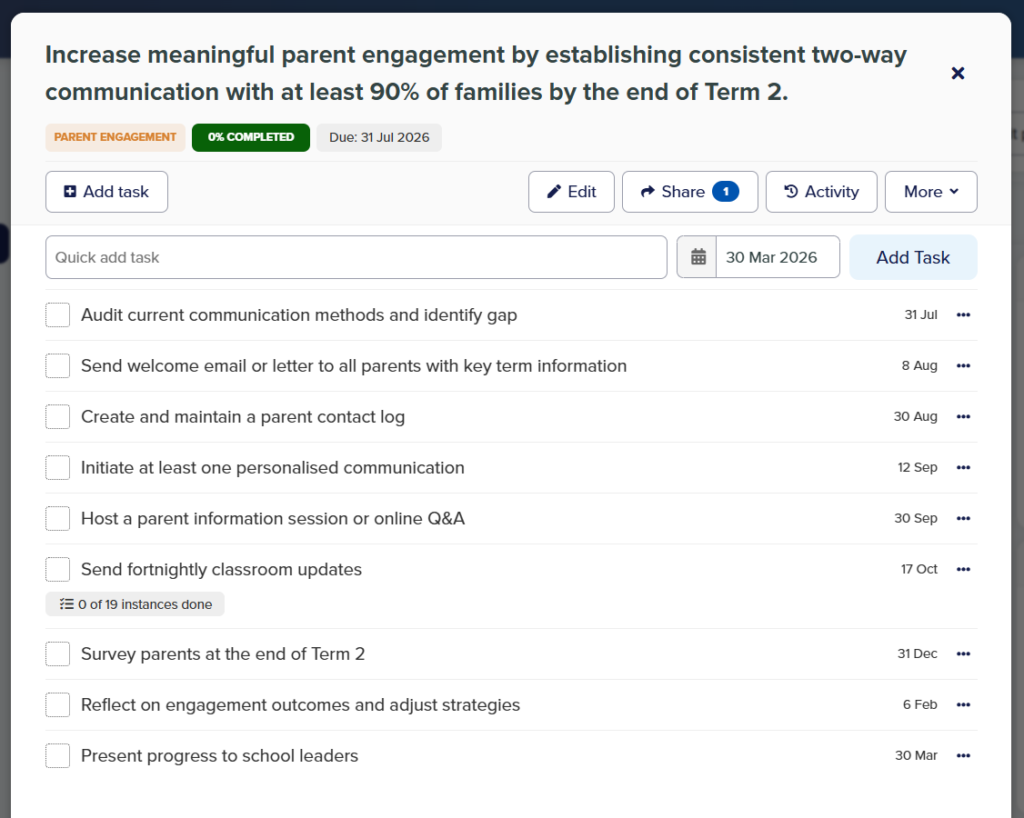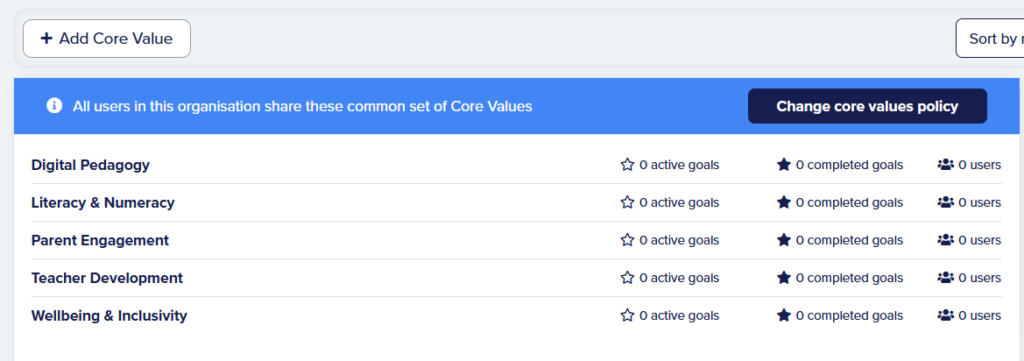Co-designing purposeful goals, building collective momentum, and sustaining growth Across the School Year
Each new school year brings a unique sense of energy and renewal. In the weeks leading up to Term 1, teachers come together in workshops, annual planning days, and team sessions—sharing ideas, aligning priorities, and setting their intentions for the year ahead. These collaborative moments lay the foundation for a successful academic year, but too often, the clarity and motivation felt during these sessions begin to fade as day-to-day demands take over.
The Annual Teacher Goal-Setting & Collaboration Program is designed to capture and extend that momentum. It provides a structured, school-wide approach that empowers teachers to set meaningful personal and team goals, track progress, stay aligned, and reflect meaningfully throughout the year. With Lifetick, these goals move beyond a one-time exercise and become living, actionable commitments that support both individual growth and collective impact.
Powered by Lifetick, it provides a structured, engaging way to set, track, and reflect on goals—both individually and as a team—ensuring that the excitement of Term 1 translates into sustained impact across the academic year.
This program follows a four-phase annual cycle aligned with the school calendar:
| Term | Focus | Purpose |
|---|---|---|
| Pre-Term / Term 1 | Collaboration & Goal Alignment | Co-design goals aligned to school priorities and team focus areas |
| Term 2 | Implementation & Support | Track progress, support peers, and build shared accountability |
| Term 3 | Refinement & Acceleration | Review and refine goals; spotlight effective practices |
| Term 4 | Review & Celebrate | Reflect, evaluate impact, and share achievements |
Term 1: Visioning & Planning
Establish direction, alignment, and buy-in
Activities:
- School Strategic Briefing
- Leadership presents key focus areas for the year (e.g., literacy growth, digital pedagogy, inclusion).
- Shared values or priorities are entered as Lifetick “core values” or focus domains.
- Team Visioning Workshops
- Teaching teams co-design team goals aligned with school goals.
Example: “Deliver 3 cross-curricular STEM units this year” - Collaborative space in Lifetick enables shared goal dashboards. Lifetick offers various kinds of sharing for teachers:
- Work on a goal together and assign tasks for each other to complete
- Assign colleagues as Supporters for certain team or individual goals. This allows them to see and comment on your goals without being responsible for completing them. Think of Supporters as Accountability Partners or Cheerleaders.
- Every goal has its
- Teaching teams co-design team goals aligned with school goals.
- Individual Goal-Setting Sessions
- Teachers set SMART personal goals that align with team and school goals.
Example: “Use formative feedback tools weekly to support writing progress”
- Teachers set SMART personal goals that align with team and school goals.
- Coaching & Approval
- Instructional leaders or team leads review and provide feedback via Lifetick.
- Final goal plans are approved and locked in.
Outcomes:
- Documented personal and team goals in Lifetick
- Team alignment and clarity on shared priorities
- Baseline for coaching and support
- Early buy-in and momentum for the year

Term 2: Implementation & Support
Drive action and maintain momentum
Activities:
- Ongoing Progress Updates
- Teachers regularly log progress in Lifetick (e.g., goal check-ins, journal entries).
- Visual dashboards show individual and team progress.
- Peer Collaboration
- Schedule structured team reflection sessions to share strategies and troubleshoot challenges.
- Use Lifetick to review shared progress toward team goals.
- Coaching Check-Ins
- Leaders meet 1:1 or in small groups for feedback conversations.
- Use platform insights to tailor support or suggest adjustments.
- Mid-Semester Adjustment Window (Optional)
- If necessary, goals can be revised with rationale and approval.
Outcomes:
- Ongoing engagement with goals
- Peer and leadership feedback cycles
- Emerging evidence of impact on practice
Term 3: Refinement & Acceleration
Refine, deepen, and scale what’s working
Activities:
- Goal Review & Adjustment
- Teachers revisit their goals:
- Are they still relevant?
- Do they need refining or expanding?
- Teachers revisit their goals:
- Showcase Best Practices
- Use Lifetick data and reflections to identify exemplars across teams.
- Spotlight strategies in staff meetings or newsletters.
- Professional Development Targeting
- Insights from team dashboards guide targeted PD or coaching.
- Example: A team struggling with assessment data may request moderation support.
- Stretch Goals (Optional)
- Teachers or teams may set optional stretch goals based on early achievement.
Outcomes:
- Revised goals (where needed)
- Visible evidence of improved practice
- Scaled collaboration across teams
Term 4: Review & Celebrate
Reflect, evaluate, and share success
Activities:
- Final Reflections & Self-Evaluation
- Teachers complete structured reflections in Lifetick:
What did I learn? What impact did I have? - Upload supporting evidence (lesson plans, student data, artifacts).
- Teachers complete structured reflections in Lifetick:
- Team Impact Review
- Teams reflect on goal achievement, outcomes, and future needs.
- Recommendations are captured for the following year’s planning.
- Goal Completion Reports
- Lifetick exports individual and team goal summaries for inclusion in performance reviews or accreditation.
- Celebration & Recognition
- End-of-year event or communication highlighting accomplishments.
- Recognize innovation, growth, collaboration, and perseverance.
Outcomes:
- Teacher-led evaluation of goal impact
- Summary reports and evidence of professional growth
- A culture of shared success and continuous improvement
Example Goal Categories (Core Values)
Here are typical categories to guide both individual and collaborative goal-setting. These should be set up as Core Values for the school. :
| Category | Sample Goals |
|---|---|
| Teaching & Learning | Implement formative assessment every lesson in Term 2 |
| Inclusion & Engagement | Improve engagement strategies for neurodiverse learners |
| Curriculum & Pedagogy | Co-develop and trial an inquiry-based science unit |
| Student Outcomes | Improve student writing levels by 1 band across the cohort |
| Professional Growth | Complete online training in trauma-informed practice |
| Team Collaboration | Run three lesson study sessions with year-level team |

Why it works
- It’s collaborative: Built from shared workshops and team planning sessions
- It’s visible: Progress is tracked and shared, not hidden in a drawer
- It’s supported: Leaders, mentors, and peers engage with goals actively
- It’s reflective: Lifetick prompts meaningful reflection throughout the year
- It’s flexible: Adjustments are welcomed as professional learning evolves
Conclusion
The Annual Teacher Goal-Setting & Collaboration Program fosters a culture of purpose, accountability, and teamwork. With Lifetick as the platform, schools gain a powerful structure to embed ongoing professional growth while uniting individuals and teams around meaningful, measurable outcomes.
It’s not just goal-setting. It’s collective growth.
Talk to us today about how we can help you set up the right program for your educators for the year ahead.